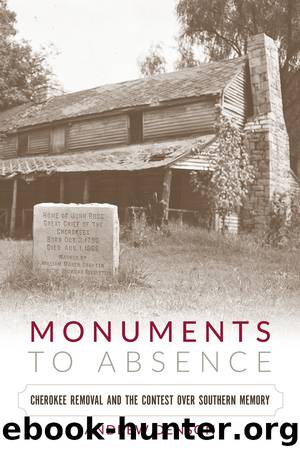Monuments to Absence by Denson Andrew;

Author:Denson, Andrew;
Language: eng
Format: epub
Publisher: The University of North Carolina Press
Tourism and Termination
By all accounts, Unto These Hills proved a spectacular success. More than 100,000 people saw the show in its first season from July through early September 1950, and attendance rose to around 150,000 the following summer. Those numbers surpassed attendance for The Lost Colony and for Paul Greenâs second outdoor drama, The Common Glory, a play about the American Revolution staged at Williamsburg. Over the next decade, attendance for Unto These Hills averaged about 130,000 each year.57 The CHA paid off its debt after only one season, and its leaders quickly made plans to expand their operations. In 1951, the association began work on a living history museum, named the Oconaluftee Indian Village, depicting Cherokee life in the mid-eighteenth century. A year later, it purchased a privately owned museum with an extensive archeological collection, the Museum of the Cherokee Indian. Like the drama, the village and the museum proved popular and profitable.58 Thanks to the CHA, the State magazine crowed, Cherokee was quickly becoming âthe biggest single travel goal in North Carolina.â59 Indian agent Joe Jennings was even more enthusiastic, calling Unto These Hills the âgreatest thing [that has] happened to the Cherokee Band since its start.â60
The striking success of Unto These Hills, however, immediately raised questions about the extent to which Cherokee people benefited from the CHAâs operations. White businessmen ran the association, after all, and the drama employed relatively few citizens of the Eastern Band. The association profited from its use of Cherokee history, but what did the tribe gain? In 1951, doubts like these inspired Cherokees to circulate a petition calling upon the CHA to transfer 10 percent of the earnings from Unto These Hills directly to the Eastern Band. The tribe could then use these funds to support better social services for the Cherokee community. The petition also demanded that the CHA employ more Cherokees.61 The State criticized this development, insisting that Indians were already the greatest beneficiaries of the drama. Some Cherokees, the magazine remarked in a patronizing tone, had forgotten how diligently men of vision like Harry Buchanan had worked to create Unto These Hills. âFrom start to finish the idea, planning and execution of the pageant came from those who had a broader goal in view than the creation of a public grab-bag.â62 The CHA rejected the call for direct payments to the tribe, but it did make an effort to convince Cherokees that its presence contributed to the tribal communityâs well-being. It promised to hire as many Cherokees as possible, and it engaged in public good works, like the establishment of a scholarship program for Cherokee students. An official history of the WNCAC described the association in terms more appropriate to a charity than a tourism enterprise. âThere is good reason to think that the Drama has renewed the Cherokeesâ pride in themselves,â the authors observed. âCertainly it has tended to bring them out of the backwater in which they have lived for many scores of years.â63 The tribal government, meanwhile, managed to acquire a more direct benefit from the CHA.
Download
This site does not store any files on its server. We only index and link to content provided by other sites. Please contact the content providers to delete copyright contents if any and email us, we'll remove relevant links or contents immediately.
| Africa | Americas |
| Arctic & Antarctica | Asia |
| Australia & Oceania | Europe |
| Middle East | Russia |
| United States | World |
| Ancient Civilizations | Military |
| Historical Study & Educational Resources |
The Dawn of Everything by David Graeber & David Wengrow(1567)
The Bomber Mafia by Malcolm Gladwell(1519)
Facing the Mountain by Daniel James Brown(1428)
Submerged Prehistory by Benjamin Jonathan; & Clive Bonsall & Catriona Pickard & Anders Fischer(1375)
Tip Top by Bill James(1291)
Wandering in Strange Lands by Morgan Jerkins(1281)
Evil Geniuses: The Unmaking of America: A Recent History by Kurt Andersen(1269)
Red Roulette : An Insider's Story of Wealth, Power, Corruption, and Vengeance in Today's China (9781982156176) by Shum Desmond(1267)
The Way of Fire and Ice: The Living Tradition of Norse Paganism by Ryan Smith(1258)
Driving While Brown: Sheriff Joe Arpaio Versus the Latino Resistance by Terry Greene Sterling & Jude Joffe-Block(1230)
American Kompromat by Craig Unger(1213)
F*cking History by The Captain(1196)
It Was All a Lie by Stuart Stevens;(1191)
American Dreams by Unknown(1153)
Treasure Islands: Tax Havens and the Men who Stole the World by Nicholas Shaxson(1151)
Evil Geniuses by Kurt Andersen(1142)
White House Inc. by Dan Alexander(1122)
The First Conspiracy by Brad Meltzer & Josh Mensch(1075)
The Fifteen Biggest Lies about the Economy: And Everything Else the Right Doesn't Want You to Know about Taxes, Jobs, and Corporate America by Joshua Holland(1029)
